Статьи журнала - Компьютерная оптика
Все статьи: 2553
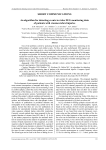
Статья научная
One of the problems solved by analyzing the data of long-term Video EEG monitoring is the differentiation of epileptic and artifact events. For this, not only multichannel EEG signals are used, but also video data analysis, since traditional methods based on the analysis of EEG wavelet spectrograms cannot reliably distinguish an epileptic seizure from a chewing artifact. In this paper, we propose an algorithm for detecting artifact events based on a joint analysis of the level of the optical flow and the ridges of wavelet spectrograms. The preliminary results of the analysis of real clinical data are given. The results show the possibility in principle of reliable distinguishing non-epileptic events from epileptic seizures.
Бесплатно
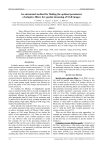
Статья научная
Many different filters can be used to reduce multiplicative speckle noise on radar images. Most of these filters have some parameters whose values influence the result of filtering. Finding optimal values of such parameters may be a non-trivial task. In this paper, a formal automated method for finding optimal parameters of speckle noise reduction filters is proposed. Using a specially designed test image, optimal parameters for the most commonly used filters were found using several image quality assessment metrics, including the Structural Similarity Index (SSIM) and Gradient Magnitude Similarity Deviation (GMSD). The use of filters with optimal parameters allows processing (detection, segmentation, etc.) of radar images with minimal influence of speckle noise.
Бесплатно
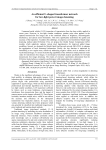
An efficient U-shaped transformer network for low-light power image denoising
Статья научная
Unmanned aerial vehicle (UAV) inspection of transmission lines has been widely applied in recent years. However, in low-light weather conditions, random noise often appears in the captured transmission line images due to the combined effects of brightness, electromagnetic interference, and camera sensor limitations. This noise significantly undermines the quality and accuracy of the inspection. To address this challenge, we propose a novel transformer-based image denoising method called EUformer. First, we propose the Global Feature Compensator (GFC) module, which adaptively captures remote pixel dependencies for improved global image modelling. Second, we designed the Mixed-Gated feed-forward network (MG-FFN), to enhance the aggregation of local contextual information. Finally, the loss function is optimized by introducing a new regular term, effectively addressing negative effects such as artefacts in the reconstructed images. To assess the denoising capabilities of the EUformer model proposed in this study for transmission line images, we developed a benchmark dataset specifically for low-light transmission line image denoising. The results of extensive experiments demonstrate that the EUformer model achieves competitive performance while maintaining low complexity.
Бесплатно
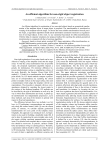
An efficient algorithm for non-rigid object registration
Статья научная
An efficient algorithm for registration of two non-rigid objects based on geometrical transformation of the template object to target object is proposed. The transformation is considered as warping of the template onto the target. To choose the most suitable transformation from all possible warps, a registration algorithm should satisfy deformation constraints referred to as regularization of non-rigid objects. In this work, we use variational functionals for affine transformations. With the help of computer simulation, the proposed method for searching the optimal geometrical transformation is compared with that of common algorithms.
Бесплатно
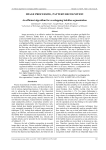
An efficient algorithm for overlapping bubbles segmentation
Статья научная
Image processing is an effective method for characterizing various two-phase gas/liquid flow systems. However, bubbly flows at a high void fraction impose significant challenges such as diverse bubble shapes and sizes, large overlapping bubble clusters occurrence, as well as out-of-focus bubbles. This study describes an efficient multi-level image processing algorithm for highly overlapping bubbles recognition. The proposed approach performs mainly in three steps: overlapping bubbles classification, contour segmentation and arcs grouping for bubble reconstruction. In the first step, we classify bubbles in the image into a solitary bubble and overlapping bubbles. The purpose of the second step is overlapping bubbles segmentation. This step is performed in two subsequent steps: at first, we classify bubble clusters into touching and communicating bubbles. Then, the boundaries of communicating bubbles are split into segments based on concave point extraction. The last step in our algorithm addresses segments grouping to merge all contour segments that belong to the same bubble and circle/ellipse fitting to reconstruct the missing part of each bubble. An application of the proposed technique to computer generated and high-speed real air bubble images is used to assess our algorithm. The developed method provides an accurate and computationally effective way for overlapping bubbles segmentation. The accuracy rate of well segmented bubbles we achieved is greater than 90 % in all cases. Moreover, a computation time equal to 12 seconds for a typical image (1 Mpx, 150 overlapping bubbles) is reached.
Бесплатно
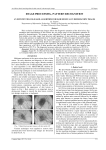
An efficient block-based algorithm for hair removal in dermoscopic images
Статья научная
Hair occlusion in dermoscopy images affects the diagnostic operation of the skin lesion. Segmentation and classification of skin lesions are two major steps of the diagnostic operation required by dermatologists. We propose a new algorithm for hair removal in dermoscopy images that includes two main stages: hair detection and inpainting. In hair detection, a morphological bottom-hat operation is implemented on Y-channel image of YIQ color space followed by a binarization operation. In inpainting, the repaired Y-channel is partitioned into 256 non-overlapped blocks and for each block, white pixels are replaced by locating the highest peak, using a histogram function and a morphological close operation. The proposed algorithm reports a true positive rate (sensitivity) of 97.36 %, a false positive rate (fall-out) of 4.25 %, and a true negative rate (specificity) of 95.75 %. The diagnostic accuracy achieved is recorded at a high level of 95.78 %.
Бесплатно
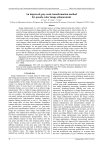
An improved gray-scale transformation method for pseudo-color image enhancement
Статья научная
Image enhancement is a very important process of image preprocessing and it plays a critical role in the improvement of image quality and the follow-up image analysis, which makes the research of image enhancement algorithm a hot research field. Image enhancement not only needs to strengthen image determination and recognition, but also needs to avoid the consequential color distortion. Pseudo-color enhancement is the technique to map different gray scales of a black-and-white image into a color image. As humans have extremely strong ability in distinguishing different colors visually and relatively weak capacity in discriminating gray scales, so, color the gray-scale changes which cannot be differentiated by human eyes so that they can tell them apart. The mapping function in conventional gray-scale transform method is not working well in dark and low-contrast images. So, this paper comes up with an improved gray-scale transformation algorithm. This algorithm can achieve the enhancement, preserve the image colors, process dark and low-contrast images, reinforce the enhancement and improve the blocking effect. The experiment proves that the enhanced image obtained by the method of this paper can have improved average brightness, natural colors and more detail information and it has good application value.
Бесплатно
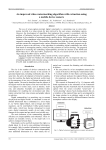
An improved video watermarking algorithm with extraction using a mobile device camera
Статья научная
The use of screen-capture-resistant digital watermarks is a promising way to store information invisibly in a video stream for later retrieval by the user using a smartphone camera. However, the development of algorithms that implement this scenario is associated with the problem of balancing between the imperceptibility of embedding and robustness. A serious problem is the extraction of watermarks using a mobile device. Most people use the vertical positioning of the smartphone when shooting, which excludes the possibility of only marked video sequences entering the frame. The extraction algorithm first finds the screen area in the image and then extracts the watermark under various distortion conditions. This study proposes an approach to improve the efficiency of the algorithm for embedding digital watermarks into video data based on rectangular patterns, which provides resistance to screen shooting. The proposed approach to increasing the embedding imperceptibility provided an increase in the PSNR and SSIM values by 17.18 % and 7.90 %, respectively. The use of a neural network at the extraction stage reduced the BER value by 64.64 %.
Бесплатно
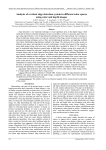
Analysis of a robust edge detection system in different color spaces using color and depth images
Статья научная
Edge detection is very important technique to reveal significant areas in the digital image, which could aids the feature extraction techniques. In fact it is possible to remove un-necessary parts from image, using edge detection. A lot of edge detection techniques has been made already, but we propose a robust evolutionary based system to extract the vital parts of the image. System is based on a lot of pre and post-processing techniques such as filters and morphological operations, and applying modified Ant Colony Optimization edge detection method to the image. The main goal is to test the system on different color spaces, and calculate the system’s performance. Another novel aspect of the research is using depth images along with color ones, which depth data is acquired by Kinect V.2 in validation part, to understand edge detection concept better in depth data. System is going to be tested with 10 benchmark test images for color and 5 images for depth format, and validate using 7 Image Quality Assessment factors such as Peak Signal-to-Noise Ratio, Mean Squared Error, Structural Similarity and more (mostly related to edges) for prove, in different color spaces and compared with other famous edge detection methods in same condition...
Бесплатно
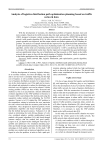
Analysis of logistics distribution path optimization planning based on traffic network data
Статья
With the development of economy, the distribution problem of logistics becomes more and more complex. Based on the traffic network data, this study analyzed the vehicle routing problem (VRP), designed a dynamic vehicle routing problem with time window (DVRPTW) model, and solved it with genetic algorithm (GA). In order to improve the performance of the algorithm, the genetic operation was improved, and the output solution was further optimized by hill climbing algorithm. The analysis of example showed that the improved GA algorithm had better performance in path optimization planning, the total cost of planning results was 31.44 % less than that of GA algorithm, and the total cost of planning results increased by 11.48 % considering the traffic network data. The experimental results show that the improved GA algorithm has good performance and can significantly reduce the cost of distribution and that research on VRP based on the traffic network data is more in line with the actual situation of logistics distribution, which is conducive to the further application of the improved GA algorithm in VRP.
Бесплатно
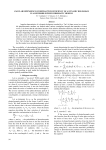
Статья научная
Angular characteristics of a dynamic hologram, recorded by a "fan" of plane waves in a reversible photochromatic medium, are studied under various correlations between the intensities of these waves. It is shown that the maximum increase of the relative diffraction efficiency with the increase of the angle between the reference and object waves is observed for thin holograms. There is such a PCM thickness beginning from which the relative dependence of the hologram diffraction efficiency upon the angle ceases to depend upon the PCM thickness, reaching some maximum distribution. Coincidence is shown of the angular characteristics of the holograms, recorded under the condition that the reference wave intensity is much greater than the object wave intensity, and of the holograms, recorded by a "fan" of plane waves of equal intensity. The hologram diffraction efficiency change is studied under the readout wave deviation from the Bragg angle. The reversibility of photochemical transformations in a number of photochromatic media (PCM) allows them to be used as non-linear media for a dynamic hologram recording [1-4]. In the works, accomplished up to now, on studying the dynamic hologram diffraction efficiency (HDE) in reversible PCM it has been considered that hologram recording is carried out by two plane waves, the surfaces of equal intensity of the recorded interference grating being perpendicular to the photochromatic layer faces [5-6]. In the present work the angular HDE dependence is investigated, knowing which, one can estimate the possibility of recording in such media the holograms of complex spatially modulated fields.
Бесплатно
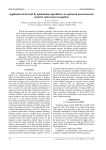
Статья научная
With the development of computer technology, there are more and more algorithms and models for data processing and analysis, which brings a new direction to radar target recognition. This study mainly analyzed the recognition of high resolution range profile (HRRP) in radar target recognition and applied the generalized regression neural network (GRNN) model for HRRP recognition. In order to improve the performance of HRRP, the fruit fly optimization algorithm (FOA) algorithm was improved to optimize the parameters of the GRNN model. Simulation experiments were carried out on three types of aircraft. The improved FOA-GRNN (IFOA-GRNN) model was compared with the radial basis function (RBF) and GRNN models. The results showed that the IFOA-GRNN model had a better convergence accuracy, the highest average recognition rate (96.4 %), the shortest average calculation time (275 s), and a good recognition rate under noise interference. The experimental results show that the IFOA-GRNN model has a good performance in radar target recognition and can be further promoted and applied in practice.
Бесплатно
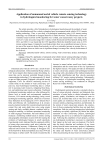
Статья научная
The article provides a brief introduction to hydrological monitoring and the methods of water body identification and flow velocity estimation based on unmanned aerial vehicle (UAV) remote sensing technology. Then, a case study of hydrological monitoring using UAV remote sensing technology was conducted on Gangnan Reservoir in Hebei Province. The effectiveness of the convolutional neural network (CNN) algorithm was verified, and measurements were made on the reservoir’s water area and average flow velocity in both flood and non-flood periods during 2020, 2021, and 2022. It was found that the CNN algorithm effectively identified water areas in UAV remote sensing images. Compared to non-flood periods, there was a significant increase in the water area of the reservoir during flood periods, as well as a noticeable increase in average flow velocity upstream; however, there was no significant change in average flow velocity downstream of the reservoir.
Бесплатно
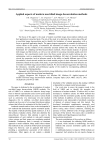
Applied aspects of modern non-blind image deconvolution methods
Статья научная
The focus of this paper is the study of modern non-blind image deconvolution methods and their application to practical tasks. The aim of the study is to determine the current state-of-the-art in non-blind image deconvolution and to identify the limitations of current approaches, with a focus on practical application details. The paper proposes approaches to examine the influence of various effects on the quality of restoration, the robustness of models to errors in blur kernel estimation, and the violation of the commonly assumed uniform blur model. We developed a benchmark for validating non-blind deconvolution methods, which includes datasets of ground truth images and blur kernels, as well as a test scheme for assessing restoration quality and error robustness. Our experimental results show that those neural network models lacking any pre-optimization, such as quantization or knowledge distillation, fall short of classical methods in several key properties, such as inference speed or the ability to handle different types of blur. Nevertheless, neural network models have made notable progress in their robustness to noise and distortions. Based on the results of the study, we provided recommendations for more effective use of modern non-blind image deconvolution methods. We also developed suggestions for improving the robustness, versatility and performance quality of the models by incorporating additional practices into the training pipeline.
Бесплатно
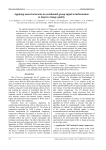
Applying neural networks in coordinated group signal transformation to improve image quality
Статья научная
The rapid development of the Internet of Things and wireless sensor networks combined with the introduction of image analysis systems and computer vision technologies has led to the emergence of a new class of systems – multimedia Internet of Things and multimedia wireless sensing networks. The combination of the specifics of the Internet of Things, which requires simultaneous and long-term operation of a large number of autonomous devices, with the need to transmit video data poses the problem of creating new energy-efficient methods of image compression. The paper considers applying coordinated group signal transformation as such an algorithm, which performs compression based on the input signals’ correlation. Correlation between the image color channels makes this possible. However, it was necessary to supplement this method by clustering the original images using machine learning methods for better image reconstruction at reception. The criterion for clustering was the change of image gradient. The use of radial neural network in the clustering algorithm increased the speed of the proposed method. The resulting algorithm provides at least fourfold image compression with high-quality image restoration. Moreover, for multimedia Internet of Things systems, in which quality losses are acceptable, it is possible to provide large compression ratios without increasing computational complexity, i.e., without increasing power consumption.
Бесплатно
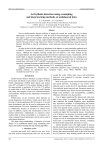
Arrhythmia detection using resampling and deep learning methods on unbalanced data
Статья научная
Due to cardiovascular diseases millions of people die around the world. One way to detect abnormality in the heart condition is with the help of electrocardiogram signal (ECG) analysis. This paper’s goal is to use machine learning and deep learning methods such as Support Vector Machines (SVM), Random Forests, Light Gradient Boosting Machine (LightGBM), Convolutional Neural Network (CNN), Long Short-Term Memory (LSTM) and Bidirectional Long Short-Term Memory (BLSTM) to classify arrhythmias, where particular interest represent the rare cases of disease. In order to deal with the problem of imbalance in the dataset we used resampling methods such as SMOTE Tomek-Links and SMOTE ENN to improve the representation ration of the minority classes. Although the machine learning models did not improve a lot when trained on the resampled dataset, the deep learning models showed more impressive results. In particular, LSTM model fitted on dataset resampled using SMOTE ENN method provides the most optimal precision-recall trade-off for the minority classes Supraventricular beat and Fusion of ventricular and normal beat, with recall of 83 % and 88 % and precision of 74 % and 66 % for the two classes respectively, whereas the macro-weighted recall is 92 % and precision is 82 %.
Бесплатно
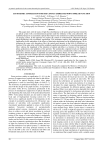
Asymmetric apodization for the comma aberrated point spread function
Статья научная
This paper deals with the study of light flux distributions in the point spread function formed by an optical system with a one-dimensional aperture under the influence of the coma aberration. The traditional design of an asymmetric optical filter improves the resolution of a diffraction-limited optical imaging system. In this approach we explore the control of monochromatic aberrations through pupil engineering with asymmetric apodization. This technique employs the amplitude and phase apodization for the mitigation of the effects of third-order aberrations on the diffracted image. On introducing the coma wave aberration effect, the central peak intensity in the field of diffraction is a function of the edge strips width and the amplitude apodization parameter of a one-dimensional pupil filter, whereas the magnitude of the reduction of optical side-lobes is a function of the degree of phase apodization at the periphery of the aperture. The analytically computed results are illustrated graphically in terms of point spread function curves under various considerations of the coma aberrations and a different degree of amplitude and phase apodization. Hence, for the optimum values of apodization, the axial resolution has been analyzed using well-defined quality criteria.
Бесплатно
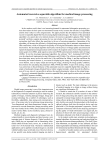
Automated recursive separable algorithm for medical image processing
Статья научная
In the modern world, there is an increasing demand for automated information processing systems that reduce the time spent on monotonous human work, increase the efficiency of algorithms and the time it takes to solve assigned tasks. The paper presents the development of an automated recursive-separable digital filter for processing digital medical images. The feature of the automated algorithm is its speed; due to its internal structure, the recursive-separable Laplacian Filter “double pyramid” performs separate processing by row and column of the image, using recirculators. The recirculator itself also affects the speed due to the use of recursion properties. Automation of the algorithm will increase the efficiency of digital image processing, due to automatic enumeration of filter coefficients, which will improve the quality of the original information almost without human intervention. The developed algorithm itself carries out the process of image quality assessment and repeats the digital processing procedure until it reaches the required values of one of the parameters: mean square error (MSE), peak signal-to-noise ratio (PSNR) and structural similarity index of image (SSIM). To test the developed automated algorithm, the software "ALF: Automated LDP Filter" was developed and implemented using QtDesigner and PySide6. The software module consists of three data entry areas, such as the mask size h, the coefficient for lifting A1 and the coefficient for increasing the central element A2, two areas for displaying the image, the original and processed, seven buttons, such as input, output and saving the image, checking the image quality condition, three buttons for calculating the parameters MSE, PSNR and SSIM. As part of the testing, a study was carried out on the performance of the automated recursive separable digital filter using the example of endoscopic images obtained from a robotic surgical complex, which showed the effectiveness of its use, since it was possible to achieve the specified parameter values on the output image.
Бесплатно

Automatic 4-mirrors system for alignment of high-power laser radiation
Статья научная
This paper presents the automated system for minimizing the deviation of the path of passage and the divergence of a secondary radiation source with parameters similar to ones of the main beam of a high-power Ti:Sa laser using mirrors in kinematic mounts on the motorized stages. As an alignment laser, the diode laser with a fiber output was used with radiation characteristics coinciding with the parameters of the main beam (wavelength, beam diameter). The successive approximation algorithm was used to minimize the beam deflection. The positioning accuracy and beam size matching were analyzed on the near-field camera and were equaled to 28.6 µm along the X-axis and 26.4 µm along the Y-axis. Beam size mismatch was equaled to 0.151 mm. The pointing accuracy was analyzed on the far-field sensor and equaled 15.34 µrad along the X axis and 12.03 µrad along the Y axis. The curvature of the wavefront was 0.06 µm.
Бесплатно

Automatic mosaic method of remote sensing images based on machine vision
Статья научная
Unmanned Aerial Vehicle (UAV) remote sensing is a commonly used technical means in modern science and technology, but currently, remote sensing images captured by UAVs need to be spliced to obtain more comprehensive information. However, current image stitching techniques generally have shortcomings such as a small number of extracted features, low matching accuracy, and poor stability. To address the above issues, this study proposes an improved remote sensing image mosaic model on the bias of the Scale Invariant Feature Transform (SIFT) algorithm. Firstly, in this study, aiming at the problem that traditional SIFT cannot meet the requirements of feature extraction and matching for unconventional remote sensing images and special texture images, normalized cross correlation (NCC) and Forstner operator are introduced to optimize it, namely, a SIFT-NCC model is constructed. On this basis, for remote sensing images with high resolution and a wide range, this study further proposes a remote sensing image automatic mosaic model that combines point features and line features. That is, a linear segment detector (LSD) is introduced to extract the line features of remote sensing images. The experimental verification results of the final SIFT-NCC-LSD show that the matching accuracy for remote sensing images with different characteristics can reach over 95 %. Therefore, SIFT-NCC-LSD has good applicability.
Бесплатно

